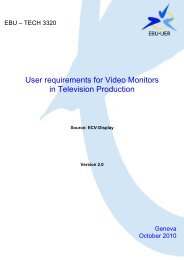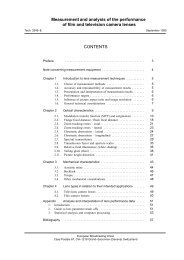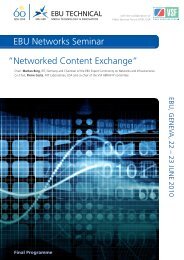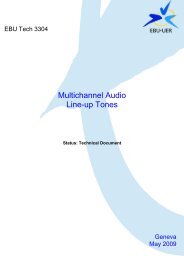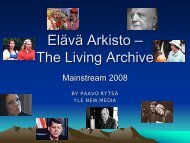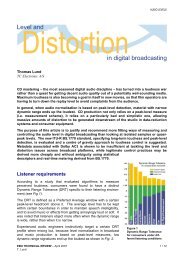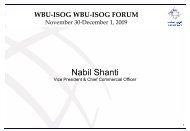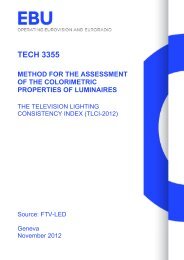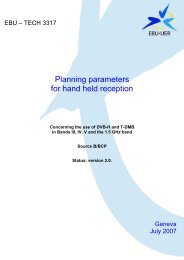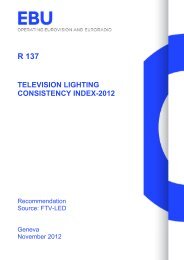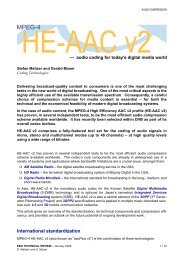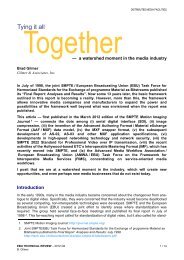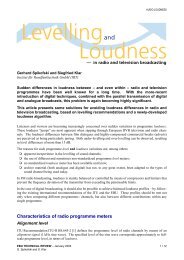Production Technology Seminar 2009 - EBU Technical
Production Technology Seminar 2009 - EBU Technical
Production Technology Seminar 2009 - EBU Technical
Create successful ePaper yourself
Turn your PDF publications into a flip-book with our unique Google optimized e-Paper software.
Is the label to be based on time or frame count?<br />
Frames (or other media unit) Time<br />
(+) Obvious way to index material, like pages in a book (+) Same for all material types. Very good e.g. for the multicamera<br />
capture – the label will match regardless of the<br />
different frame rates or type of application.<br />
(-) But different for different material types: audio and video<br />
media units different… and establishing the correspondence<br />
between labels may work not so well<br />
(-) But numbers don‟t increment simply – the frame rate may<br />
not be exactly locked to your Time Code.<br />
You may think it does not matter to choose time or frame count, because you can convert one to the<br />
other world, but it is not so straightforward as one may think.<br />
The phase of the essence signal which has been labelled makes a difference. If your decision boundary<br />
for whether this time matches to one frame count or to the next is close to the actual frame boundary,<br />
there can be difficulties.<br />
And you must rely on a constant frame rate exactly related to the time.<br />
To address these questions of frame versus time, it was decided to basically include both types of<br />
labelling, depending on the application, in 2 proposals.<br />
TRL Type 1<br />
Includes: a timestamp to high precision fraction of a second (960 Hz resolution = ~1.0416 ms), a<br />
sufficient size to count up to AD 2117, information about time zone, leap seconds etc. It also includes the<br />
media unit rate (nominal rate).<br />
Use: e.g. acquisition time, for variable rate, over/undercranking or all speed cameras.<br />
TRL Type 2<br />
It includes: a media unit number which is basically an incrementing count (e.g; frames), the media unit<br />
rate (can only be the nominal rate), plus the time stamp of the 1 st unit you have labelled or phase datum<br />
(allowing to calculate the current timestamp, assuming your media unit is locked to time and constant).<br />
Use: e.g. postproduction EDL.<br />
Binding<br />
There is no use defining a label if we can‟t store it or carry it throughout the system without it being lost.<br />
It is not too difficult to include one additional field, or to add a bit of extra information to files formats, to<br />
packet data. It just become more difficult with synchronous streams (such as SDI video, or AES3 audio,<br />
etc.) with a constrained data size and with plenty of devices which will strip off the information.<br />
2.8 How can you possibly synchronise a TV plant using Ethernet?<br />
Bob Edge, Manger, Standards and technology, Thomson Grass Valley<br />
The computer industry has been working on IP network time synchronisation for decades. Most IP<br />
network solutions (protocols) have accuracies measured in milliseconds, digital TV plants can operate<br />
with 50 nanoseconds or more of jitter. Why is IP network jitter so difficult to control? How does<br />
IEEE 1588 21 solve the problems?<br />
In an ISO layered network [4] with a master clock on one device, timing protocol messages start at the<br />
application layer, then are then sent through the layered software network stack, they are then<br />
transferred on a physical network as a packet which is received by the layered software network stack<br />
on the receiver side, and finally delivered to the application layer in the receiver. The network timing<br />
protocol manages these packets at the application layer on each device. In an ideal world application<br />
21 IEEE standard for a Precision Clock Synchronisation Protocol for Networked Measurement and Control. 2002 / July 2008<br />
© <strong>EBU</strong> <strong>2009</strong> / <strong>Production</strong> <strong>Technology</strong> seminar / January 27 - 29, <strong>2009</strong><br />
Reproduction prohibited without written permission of <strong>EBU</strong> TECHNICAL & <strong>EBU</strong> TRAINING<br />
33



